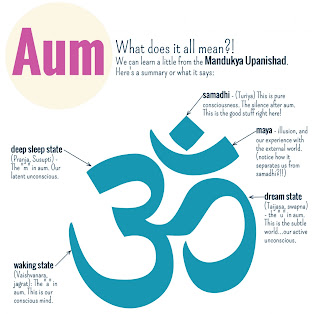Meaning of Om (Aum)
 |
| Photo Credit: Reddit |
Meaning of Om (Aum)
One finds the first references to ‘Om’ is in the
Mandukya Upanishad. Om is said to be imperishable in this text and to be all
states of time, past, present, and future, as well as transcending time itself. The
symbol consists of 5 parts – Lower Large Curve, Upper Smaller Curve, Middle
Curve, The Dot, Maya (the Crescent).
Each aspect of Om’s visual form represents a
different state of reality. The large lower curve represents the normal waking
state, where the mind identifies with the physical body and perceives the world
through the sense in this state.
The upper curve represents the unconscious state,
or deep sleep (Sushupti). This is a state of complete unconsciousness in which one
is in a deep, dreamless sleep and has withdrawn from all physical and mental
activities.
The middle curve (Swapna) represents the dream
state. The dream state occurs between deep sleep and waking sleep and is where
a person explores their subconscious. As our fears, hopes, and desires manifest
in an imaginary world, our consciousness turns inwards.
The dot represents enlightenment. In this state, a
person becomes in tune with the absolute, realising that all creation is made up of spirit and that
they are all connected by that commonality. This state transcends the ordinary
senses and can only be attained by connecting with spiritual energy.
Maya is represented by the
crescent, which separates the three curves from the dot. Maya is the illusion
that binds a person’s soul to the physical world. By chanting Om, one can reach
the dot of enlightenment and transcend the three curves of material
consciousness. The meaning of Om is simple. Om encompasses everything in
the universe and is the essence of ultimate reality. The vibrations produced by
the Om sound energise the chakras throughout the body, particularly the third
eye and crown chakras, which assist us in connecting with our Divine selves.
It is believed that the God of Creation “Brahma’s”
thoughts caused a vibration that became the sound Om, which resulted in the
creation of the world. Om is also known as Pranava, which means “control
of one’s life force.”
As faiths are generally built around some holy
trinity, the three phonetic components of Aum represent the rule of three. Aum
represents not only the three states of consciousness but also the three
realms: Earth, Heaven, and the Underworld, as well as the Hindu Gods: Brahma (the Creator),
Vishnu (the Preserver), and Shiva (the Destroyer).



Comments